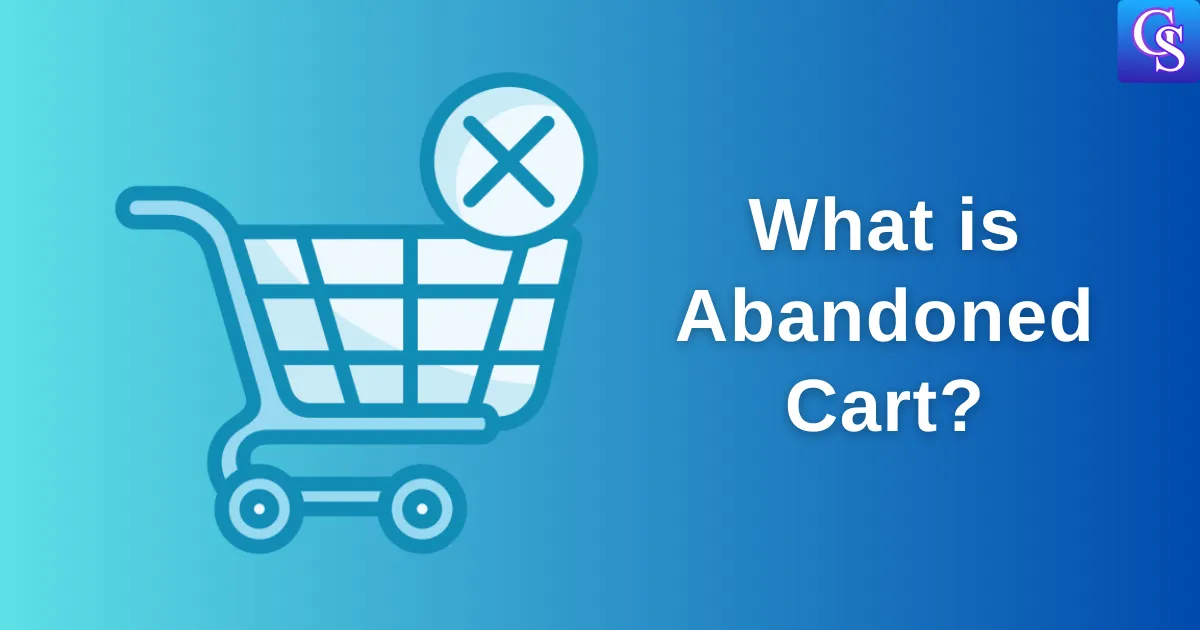Picture this: You’re browsing online, find a pair of shoes you love, and add them to your cart. But then… life happens! The phone rings, your dog needs a walk, or you suddenly remember that load of laundry. You close the website and completely forget about those shoes.
That’s an abandoned cart – like leaving a full shopping basket in the middle of the store! 🛒💨
It happens all the time online. But why? And what can shops do to stop it? 🤔
We’ve got the answers!
Table of Contents
ToggleWhat is an Abandoned Cart?
In the world of online shopping, an “abandoned cart” occurs when a potential customer adds items to their online shopping cart but leaves the website without completing the purchase.
This is typically defined as leaving the cart inactive for 30 minutes or more. Research indicates that a significant number of online shopping carts are abandoned, with the average rate being 69.99% across 48 studies. Understanding this phenomenon, why it happens, and how to reduce it is crucial for any online business aiming to maximize revenue and enhance the customer experience.
Why do shoppers abandon their carts?
There are numerous reasons why shoppers might abandon their carts. These reasons can be broadly categorized into issues related to cost, website usability, and trust, as well as the customer’s own evolving intentions.
Cost-Related Issues
- Unexpected costs: High shipping costs, taxes, or other fees added at checkout can be a major deterrent. Shoppers may be initially drawn to a product’s price but become discouraged when presented with unexpected additions to the final cost. In fact, 48% of shoppers have abandoned a cart in the last three months because extra costs were too high. This highlights the importance of transparent pricing throughout the entire shopping journey.
Website and Usability Issues
- Complicated checkout process: A long or confusing checkout process can frustrate shoppers and lead to abandonment. If the process requires excessive information or involves too many steps, shoppers may lose patience and leave.
- Website performance issues: Slow loading times, website errors, or a poor mobile experience can all contribute to cart abandonment. A seamless and efficient online experience is crucial for retaining customers.
- Inconsistent checkout experience: Inconsistencies in design, branding, or messaging across different stages of the checkout process can confuse shoppers. Maintaining a consistent and user-friendly interface throughout the checkout process is essential.
- Out-of-stock items: Discovering that an item is out of stock after adding it to their cart can be frustrating for shoppers. This can lead them to abandon their cart and search for the item elsewhere.
Trust and Security Issues
- Lack of trust elements: Shoppers may hesitate to enter their payment information on a website that doesn’t appear secure or trustworthy. A lack of trust badges, secure payment gateways, or customer reviews can all contribute to this.
- False declines: False declines occur when a legitimate credit card transaction is mistakenly rejected by the payment processor. This can be a frustrating experience for customers and may lead them to abandon their cart. Businesses can minimize false declines by working closely with their payment processors and implementing fraud prevention measures that do not unduly inconvenience legitimate customers.
Customer-Specific Issues
- Simply changing their mind: Sometimes, shoppers may add items to their cart without a firm intention to purchase them. They may be browsing, comparing prices, or saving items for later consideration, and ultimately decide not to buy.
- Mandatory account creation: Forcing shoppers to create an account before completing their purchase can be a major deterrent. Many shoppers prefer the convenience of guest checkout, and requiring account creation adds an unnecessary step.
- Ambiguous return policies: Unclear or restrictive return policies can make shoppers hesitant. If shoppers are unsure about the return process or feel that it is too complicated, they may abandon their cart.
- Limited payment options: Not offering enough payment options can be a major inconvenience. Shoppers may prefer specific methods like PayPal, Apple Pay, or “buy now, pay later” services like Shop Pay Installments, Klarna, and Afterpay. The availability of diverse payment options caters to a wider range of customer preferences and can significantly reduce cart abandonment.
Abandoned Cart Statistics
To further illustrate the impact of abandoned carts, here are some key statistics presented in a clear and organized format:
| Statistic | Value |
|---|---|
| Average cart abandonment rate | 69.99% |
| Mobile cart abandonment rate | 85.65% |
| Estimated value of products in abandoned carts annually | $4 trillion |
| Percentage of abandoners who return to the website after seeing retargeting ads | Up to 26% |
| Open rate of cart abandonment emails | 39.07% |
| Click-through rate of cart abandonment emails | 23.33% |
The Impact of Abandoned Carts
Abandoned carts have a significant impact on e-commerce businesses, leading to various financial and operational challenges:
- Lost revenue: The most direct impact is the loss of potential sales. When shoppers abandon their carts, businesses lose the immediate revenue that those completed purchases would have generated. It’s estimated that $260 billion worth of revenue lost to cart abandonment could be recovered by addressing the underlying causes.
- Increased cost per conversion: Cart abandonment not only hurts earnings but also makes each successful sale more expensive. Companies need to invest more in advertising and marketing to win back customers who have abandoned their carts, increasing the overall cost of acquiring a customer.
- Damaged customer relationships: A poor checkout experience can negatively impact how customers perceive a business. Shoppers who encounter frustrating obstacles during checkout may be less likely to return for future purchases, potentially damaging long-term customer relationships.
- Skewed business metrics: Cart abandonment can distort key business metrics, such as conversion rate and average order value. This can make it difficult to accurately assess the performance of an e-commerce business and make informed decisions about marketing and operations.
How to Reduce Cart Abandonment
While some cart abandonment is inevitable, e-commerce businesses can implement various strategies to mitigate its impact and recover lost sales. These strategies can be grouped into those that improve the checkout process, enhance website usability, build trust, and leverage targeted communication:
Optimizing the Checkout Process
- Simplify and streamline the checkout: Make the checkout process as simple and straightforward as possible. Reduce the number of steps required, offer guest checkout, and ensure the process is mobile-friendly. This can involve minimizing the number of form fields, clearly labeling each step, and providing progress indicators.
- Offer transparent pricing: Be upfront about all costs, including shipping, taxes, and fees. Avoid surprising shoppers with unexpected charges at checkout. Clearly display the total cost throughout the shopping journey, and consider offering shipping calculators or estimates early in the process.
Enhancing Website Usability
- Improve website performance: Ensure your website loads quickly and is easy to navigate. Optimize your website for mobile devices to provide a seamless shopping experience across all platforms. This is crucial since mobile users have the highest cart abandonment rate.
- Offer clear and concise return policies: Make your return policy easy to understand and accessible. Offer hassle-free returns to increase shopper confidence and reduce hesitation during checkout.
Building Trust and Security
- Build trust and security: Display trust badges, use a secure payment gateway, and provide clear contact information. This helps reassure shoppers that their payment information is safe and that the business is legitimate.
- Offer a variety of payment options: Provide multiple payment options to cater to different preferences. Accept credit cards, debit cards, digital wallets, and other popular payment methods, including alternative options like Shop Pay, PayPal, and “buy now, pay later” services.
Leveraging Targeted Communication
- Provide excellent customer support: Offer live chat, email support, or a phone number for shoppers who need assistance. This can help resolve issues that may be preventing shoppers from completing their purchase. FAQs and readily available help resources can also empower customers to find solutions independently.
- Use abandoned cart emails: Send automated emails to shoppers who have abandoned their carts. These emails can remind shoppers of the items they left behind, offer incentives to complete their purchase, and provide reassurance about security and customer support. Effective email content often includes product images, personalized messages, and discounts.
- Use retargeting ads: Show targeted ads to shoppers who have abandoned their carts. These ads can remind shoppers of the items they were interested in and encourage them to return to your website.
Conclusion
Abandoned carts represent a significant challenge for e-commerce businesses, potentially leading to substantial revenue loss and hindering business growth. The financial impact can be substantial, with billions of dollars in potential sales left unrealized each year. However, by understanding the reasons behind cart abandonment and implementing the strategies outlined above, businesses can significantly reduce cart abandonment rates and recover lost revenue.
Optimizing the checkout process, offering transparent pricing, building trust, and providing excellent customer support are crucial steps towards creating a positive shopping experience that encourages customers to complete their purchases. Additionally, leveraging targeted communication through abandoned cart emails and retargeting ads can effectively re-engage customers and bring them back to complete their transactions.
For businesses operating in the online space, utilizing tools and technologies that facilitate a smooth and user-friendly checkout experience is essential. E-commerce platforms like Shopify and BigCommerce offer various features and integrations that can help reduce cart abandonment. Implementing analytics platforms like Google Analytics can also provide valuable insights into customer behavior and identify areas for improvement in the checkout process.
By taking a proactive approach to addressing cart abandonment, e-commerce businesses can not only recover lost revenue but also enhance customer satisfaction and foster long-term loyalty. This, in turn, contributes to a healthier bottom line and sustainable business growth.



